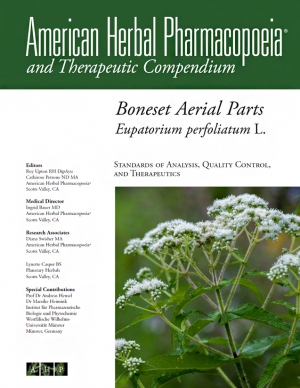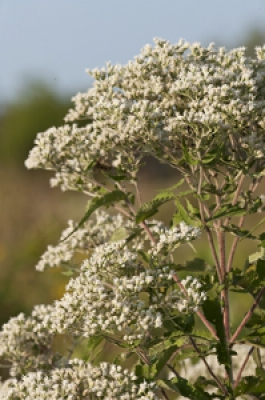By Connor Yearsley
 In
October 2019, the American Herbal Pharmacopoeia (AHP) released a monograph
containing quality control standards and a therapeutic compendium (as one
document) for boneset (Eupatorium
perfoliatum, Asteraceae) aerial parts.1 In
October 2019, the American Herbal Pharmacopoeia (AHP) released a monograph
containing quality control standards and a therapeutic compendium (as one
document) for boneset (Eupatorium
perfoliatum, Asteraceae) aerial parts.1
AHP
claims that this
is the first formal monograph on boneset, which may be one of the most
effective anti-influenza plants in the North American materia medica. The
monograph’s development involved original, in-depth analyses of boneset’s
chemistry, which confirmed the presence of potentially toxic pyrrolizidine
alkaloids (PAs) in the plant. This suggests the need for a more rigorous risk-benefit
assessment or the creation of PA-free preparations of boneset.
AHP
monographs establish identification, purity, and quality standards for
botanical raw materials and preparations. The therapeutic compendia provide a
comprehensive review of pharmacological and safety data, including medical
indications and evidence from clinical, animal, and in vitro studies; modern
and traditional uses; pharmacokinetics; pharmacodynamics; and guidance for
structure and function claims. The compendia also cover dosages, interactions,
side effects, contraindications, toxicology, and more. This information can be
used by individuals in the herbal community, from consumers and health
practitioners to industry members like quality control personnel, purchasing
agents, and dietary supplement manufacturers.
The
boneset monograph was a collaboration among AHP and researchers at Westfälische
Wilhelms-Universität in Münster, Germany. Chemical analyses of boneset were
performed by Steven Colegate, PhD, Dale Gardner, PhD, and Kip Panter, PhD, of
the United States Department of Agriculture’s (USDA’s) Poisonous Plant Research
Laboratory and Joseph Betz, PhD, of the National Institutes of Health’s (NIH’s)
Office of Dietary Supplements. In all, 12 authors contributed to the monograph,
and 18 experts in the fields of herbal medicine, botany, chemistry,
pharmacognosy, pharmacology, and boneset cultivation reviewed it before
publication. Work
on the monograph began in 2014.
According
to Roy
Upton, RH
(AHG), DipAyu, president of AHP and editor of the monograph, AHP
began developing the monograph due to boneset’s reported high degree of
efficacy during flu epidemics of the 1800s and early 1900s. “Boneset is one of
few herbs whose efficacy was compared against conventional treatments at the
time, and it was clearly saving lives when conventional therapies of the day
were failing,” Upton wrote (email, November 14, 2019). “It was also one of the
most widely used herbs by herbal physicians and practitioners of the time for
flu. Considering that flu is always a public health issue, the need for effective
medicines is apparent. We thought more people should know about boneset.”
Besides
AHP’s cannabis (Cannabis spp.,
Cannabaceae) monograph, which was published in 2014, the boneset monograph was
the most difficult to develop, according to Upton. In 2015, far into the
monograph’s development, researchers at the University of Mississippi unrelatedly
reported the presence of potentially toxic PAs in boneset.2 Though common in other Eupatorium species, these compounds had
never before been reported in boneset specifically, Upton explained. But, the
researchers analyzed only one sample, including the root, even though the
flowering tops were most often used traditionally.
At AHP’s
request, PA analytical experts at the USDA analyzed the flowering tops of three
boneset samples and found a wide range of PA variability among them. AHP then
gathered, pressed, and identified more than 40 boneset specimens and sent them
to USDA analysts, along with blinded controls (both positive and negative) that
included herbs known to possess potentially toxic PAs (e.g., comfrey [Symphytum spp., Boraginaceae] and
coltsfoot [Tussilago farfara,
Asteraceae]), herbs that contain non-toxic PAs (e.g., echinacea [Echinacea spp., Asteraceae]), and herbs
not known and unlikely to contain PAs (e.g., stinging nettle [Urtica dioica, Urticaceae]), among
others. Some commercial boneset tinctures also were included, and the analysts
were told how to make an infusion and decoction at dosages consistent with
traditional use, since, historically, boneset was prepared mostly as tea. known to possess potentially toxic PAs (e.g., comfrey [Symphytum spp., Boraginaceae] and
coltsfoot [Tussilago farfara,
Asteraceae]), herbs that contain non-toxic PAs (e.g., echinacea [Echinacea spp., Asteraceae]), and herbs
not known and unlikely to contain PAs (e.g., stinging nettle [Urtica dioica, Urticaceae]), among
others. Some commercial boneset tinctures also were included, and the analysts
were told how to make an infusion and decoction at dosages consistent with
traditional use, since, historically, boneset was prepared mostly as tea.
To AHP’s
dismay, all authenticated boneset samples and the teas and tinctures tested
positive for the potentially hepatotoxic PAs lycopsamine and intermedine. Though
the observed concentrations of these PAs in boneset were very low, according to
Upton, they still exceeded interim rules established for herbal medicinal
products (HMPs) in the European Union (EU).
The
monograph was delayed for about two years while AHP gathered the samples,
conducted the analyses, interpreted the data, and published the results.3
AHP also immediately reported its findings through its Herbal QRS Bulletin, and some companies removed boneset
from their products, even though the risk of hepatotoxicity is likely low in
general, according to Upton. Plus, boneset often is used only for short periods
of time. Still, some populations, such as fetuses, infants, and people with
already-compromised livers, are potentially sensitive to these PAs. Also,
because PAs are cleared through hepatic glutathione systems, clearance may be
less efficient or may not occur if these systems are compromised.
Upton
noted that commercial honey is one of the greatest exposure risks for
potentially toxic PAs4 and typically contains much higher PA
concentrations than boneset does, but the EU has not established PA limits for commercial
foods like honey.
PAs in honey may
be a potential contributor of hepatic disease of unknown origin. Other evidence
suggests that, over multiple millennia, humans have adapted to deal with
exposure to the less toxic PAs.5 In any case, formal toxicology
studies are needed to determine if the PA concentrations in boneset, given at
the dosages typically administered, are toxic. AHP could have conducted animal
toxicology studies to help determine this, but it chose not to deviate from its
longstanding no-animal testing policy.
 Because of
the PA issue, AHP “had to wrestle with whether” to publish the monograph, but
after consulting with some of its primary advisors and longtime members, “all
agreed that it was important to publish this,” Upton wrote. “We hope that regulators will use the information
in the monograph as a way to set rational limits for boneset and other herbs
that contain low levels of these compounds.” Because of
the PA issue, AHP “had to wrestle with whether” to publish the monograph, but
after consulting with some of its primary advisors and longtime members, “all
agreed that it was important to publish this,” Upton wrote. “We hope that regulators will use the information
in the monograph as a way to set rational limits for boneset and other herbs
that contain low levels of these compounds.”
In
an AHP press release about the monograph, Upton was quoted as saying: “Because of the high degree of efficacy that [past]
physicians reported regarding boneset, it is not an herb that should be lost
from the materia medica. Perhaps it
should no longer be used in common herbal bitters formulas, which are consumed
more freely and frequently, but if I had a flu, I would not count out boneset.”
The
boneset monograph is the 40th monograph published by AHP since 1998. It is
available for purchase through AHP’s website1 and was made possible
by the financial support of EuroPharma USA, Nature’s Way, NOW Foods, Planetary
Herbals, and Traditional Medicinals.
About Boneset
Native
to eastern North America, boneset is a clump-forming perennial in the sunflower
(Asteraceae) family. It prefers shady, moist areas and reaches four to six feet
tall, with flat-topped clusters of small, fluffy, white flowers.1,6
Boneset provides nectar for butterflies like the white-M hairstreak and bronze
copper butterfly.7 The species name perfoliatum means “through the foliage,” because the plant’s hairy
stem appears to perforate the bases of its wrinkled, opposite, lance-shaped
leaves. All parts of the plant are bitter.1,6
Accounts
vary on the origin of the name boneset. In the 1800s, the plant was used for
“breakbone fever” (a name that refers primarily to dengue fever) and “intermittent
fevers” (a telltale symptom of malaria). Both dengue and malaria can cause
joint and bone pain. Boneset sometimes was used as a quinine substitute. Native
American tribes have used boneset as an antipyretic and cold remedy. They also
have soaked broken bones in boneset tea. Native American use of boneset led to
its introduction into American allopathic, Eclectic, and Thomsonian medical
practices. The Eclectic physicians used boneset as a diaphoretic (to induce
perspiration) and emetic. Modern naturopaths and herbalists still use boneset
for flu, cough, and pain, as well as for its laxative and diaphoretic effects.1
Image credits: Boneset monograph cover courtesy of AHP. Boneset photos ©2019 Steven Foster.
References
- AHP
Monographs — Boneset Aerial Parts. American Herbal Pharmacopoeia website.
Available at: herbal-ahp.org/online-ordering-boneset-aerial-parts/.
Accessed December 10, 2019.
- Avula B, Sagi S, Wang YH, Zweigenbaum J, Wang M, Khan IA.
Characterization
and screening of pyrrolizidine alkaloids and N-oxides from botanicals and
dietary supplements using UHPLC-high resolution mass spectrometry. Food Chem. 2015;178:136-48.
- Colegate SM, Upton R, Gardner DR, Panter KE, Betz JM. Potentially toxic
pyrrolizidine alkaloids in Eupatorium
perfoliatum and three related species. Implications for herbal use as
boneset. Phytochem Anal. 2018;29(6):613-26.
- Scientific
Opinion on Pyrrolizidine alkaloids in food and feed. EFSA Journal. 2011;9(11):2406.
- Habs
M, Binder K, Krauss S, et al. A Balanced Risk-Benefit Analysis to Determine
Human Risks Associated with Pyrrolizidine Alkaloids (PA)—The Case of Tea and
Herbal Infusions. Nutrients. 2017;9(7):717.
- Eupatorium perfoliatum. Missouri
Botanical Garden website. Available at: www.missouribotanicalgarden.org/PlantFinder/PlantFinderDetails.aspx?taxonid=277187&isprofile=1&basic=Eupatorium%20perfoliatum.
Accessed December 10, 2019.
- Common
Boneset. EOL website. Available at: eol.org/pages/475561/articles.
Accessed December 10, 2019.
|